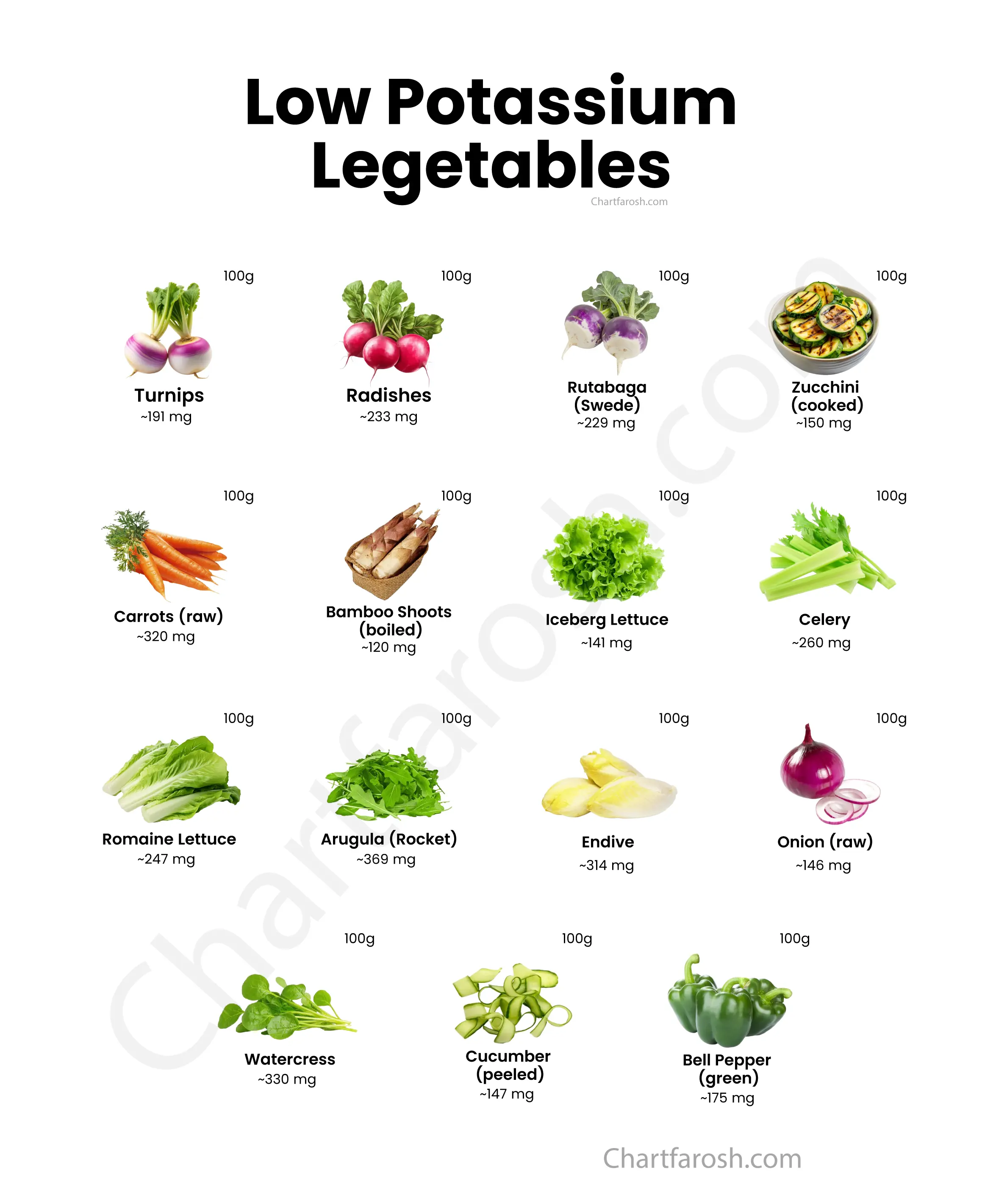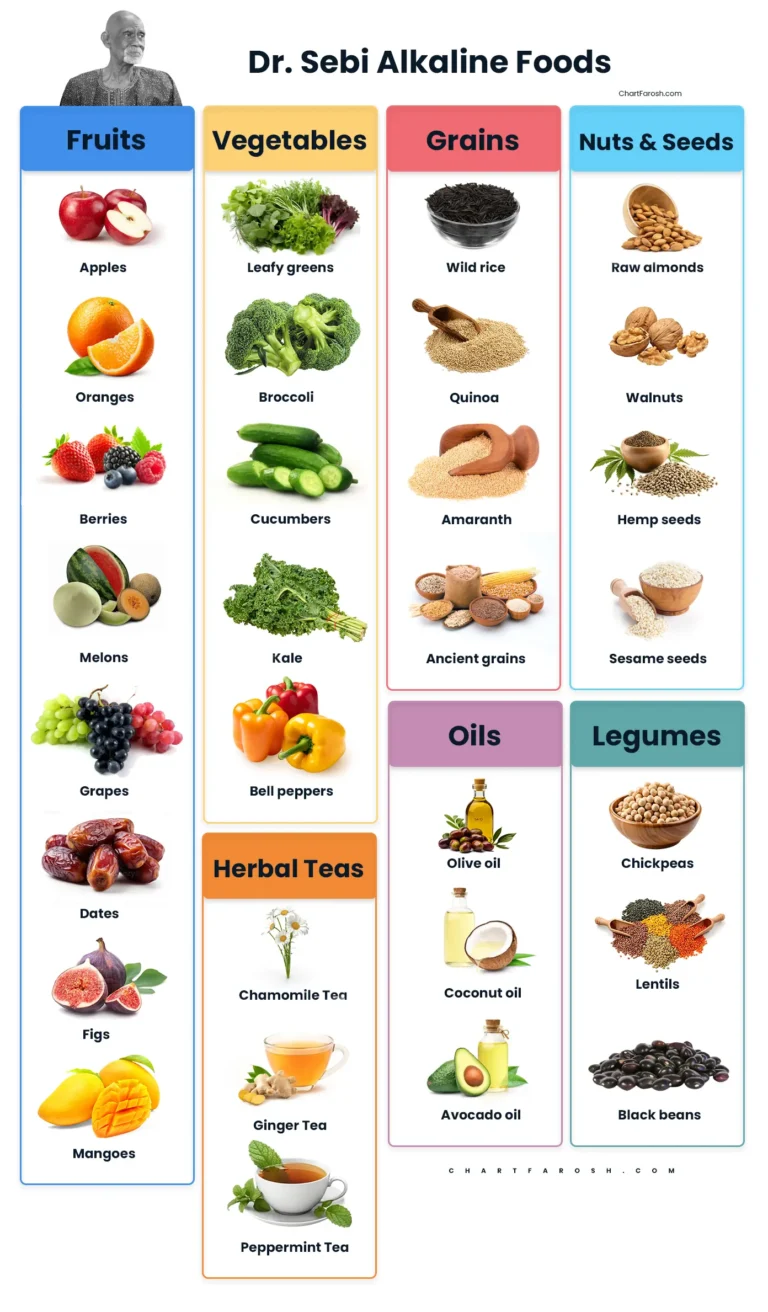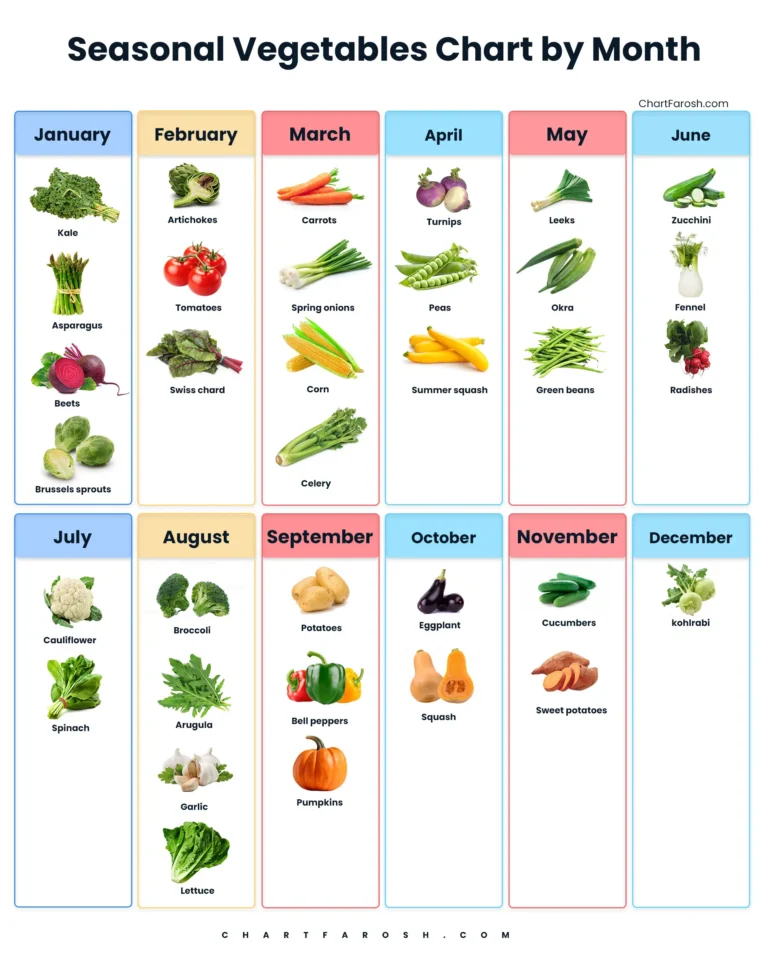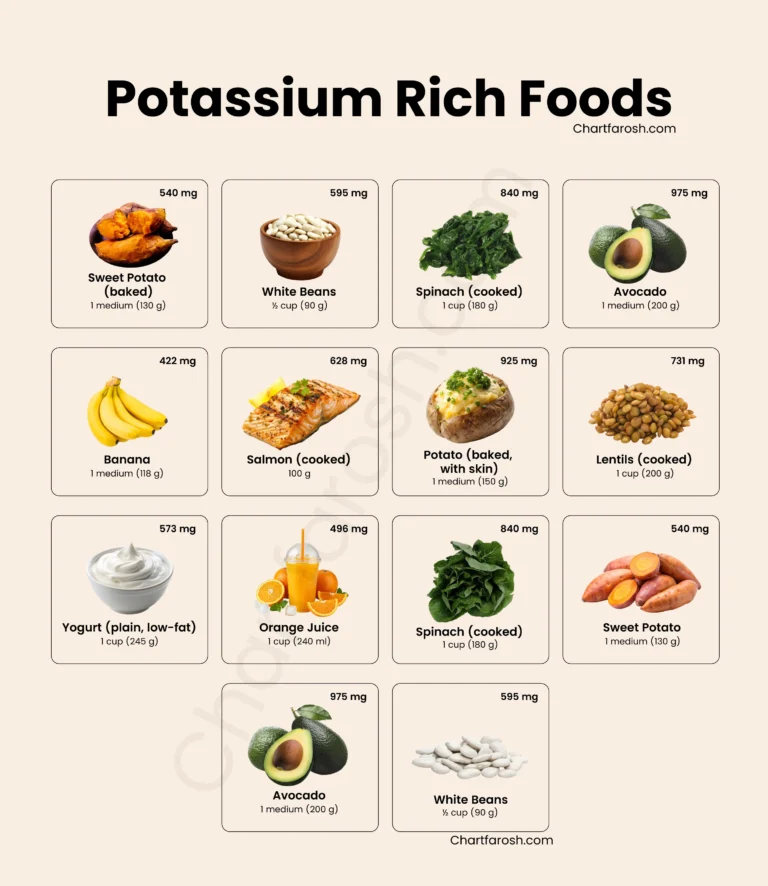Low Potassium Vegetables Chart – A Complete Guide
When a family member of mine was advised to follow a low-potassium diet, I realized how tricky it could be to figure out which vegetables were safe. At first glance, vegetables all seem healthy, but when you’re dealing with kidney concerns or managing potassium intake, some can actually be too high.
Suddenly, I was standing in the grocery store wondering, “Is this safe, or should we skip it?” That’s when I started building my own list of low potassium vegetables to make meal planning easier.
The good news is there are plenty of tasty, nutritious vegetables with low potassium that can fit into everyday meals. You don’t have to give up variety, it’s more about knowing which ones are better choices and how to prepare them.

Table of Contents
Low Potassium Root Vegetables
Root vegetables are comfort foods for many people, think carrots, parsnips, and turnips. The challenge is that some root vegetables (like potatoes and sweet potatoes) are naturally high in potassium. But there are still options that fall into the safe zone for low-potassium diets.
Vegetables like rutabaga, daikon radish, and even certain types of squash are lower in potassium compared to starchy staples. They can be roasted, mashed, or added to soups without pushing potassium levels too high. Boiling root vegetables and draining the water can also help reduce potassium content, which is a useful tip for kidney patients.
| Vegetable | Serving Size | Potassium | Notes |
| Turnips | 100g | ~191 mg | Mild flavor, versatile |
| Radishes | 100g | ~233 mg | Crunchy, peppery |
| Rutabaga (Swede) | 100g | ~229 mg | Sweeter than turnip |
| Carrots (raw) | 100g | ~320 mg | Moderate, safe in portions |
| Bamboo Shoots (boiled) | 100g | ~120 mg | Very low potassium |
Low Potassium Green Leafy Vegetables
When we think leafy greens, spinach often comes to mind but spinach is actually high in potassium. But the truth is that not all greens are off the table. Options like lettuce (iceberg, romaine), cabbage, and kale (in smaller portions) are considered vegetables with low potassium compared to darker, denser greens.
These greens can be the base of salads, tossed into soups, or used as wraps. They provide vitamins and fiber without the potassium overload. Leafy greens are also versatile, you can mix and match to keep meals fresh while still sticking to a safe list of low potassium vegetables.
| Vegetable | Serving Size | Potassium | Notes |
| Iceberg Lettuce | 100g | ~141 mg | One of the lowest potassium greens |
| Romaine Lettuce | 100g | ~247 mg | Crisp & hydrating |
| Arugula (Rocket) | 100g | ~369 mg | Moderate, use small portions |
| Endive | 100g | ~314 mg | Bitter leafy green |
| Watercress | 100g | ~330 mg | Peppery, use in moderation |
Low Potassium Salad Vegetables
Salads are a big part of healthy eating, but they can be tricky if you’re watching potassium. Tomatoes, for example, are moderately high, especially when concentrated into sauces. Luckily, plenty of salad staples are naturally low in potassium.
Think cucumbers, bell peppers, radishes, and iceberg lettuce. These light, crunchy veggies are refreshing, low in calories, and great low potassium foods to eat on hot days. Pairing them with a simple vinaigrette or lean protein turns them into a balanced meal without worrying about excess potassium.
| Vegetable | Serving Size | Potassium | Notes |
| Cucumber (peeled) | 100g | ~147 mg | Refreshing, very low |
| Bell Pepper (green) | 100g | ~175 mg | Sweet & crunchy |
| Zucchini (cooked) | 100g | ~150 mg | Light, low carb |
| Celery | 100g | ~260 mg | Crisp, hydrating |
| Onion (raw) | 100g | ~146 mg | Adds flavor, safe |
Low Carb Low Potassium Vegetables
If you’re juggling both carb and potassium restrictions, finding vegetables that tick both boxes can feel like a double challenge. People with kidney issues often also need to manage blood sugar, and that means keeping carbs in check.
There’s a surprisingly large variety of vegetables with low potassium that are also low in carbs, so you don’t have to feel boxed in when planning meals.
| Vegetable | Serving Size | Potassium | Carbs | Notes |
| Cucumber (peeled) | 100g | ~147 mg | 3.6g | Excellent for low-carb diets |
| Zucchini | 100g | ~150 mg | 3.1g | Low-carb substitute for pasta |
| Radish | 100g | ~233 mg | 3.4g | Crunchy, low carb |
| Celery | 100g | ~260 mg | 3g | Low calorie & hydrating |
| Iceberg Lettuce | 100g | ~141 mg | 2.9g | Very low carb & potassium |
Cooking Tips to Reduce Potassium in Vegetables
Even higher-potassium vegetables can sometimes be included if prepared correctly. Cooking methods can make a big difference in the potassium content of veggies. This is something many people don’t realize, the way you prepare your food can change its nutrition significantly.
Boiling and leaching are the two most recommended methods for reducing potassium in vegetables. For example, a raw potato may be too high in potassium to safely eat, but if you peel, chop, soak, and boil it in plenty of water, the potassium content drops drastically. This makes certain off-limits vegetables occasionally manageable for those on restricted diets.
- Double boiling: Chop vegetables, boil them in water, drain, then boil again in fresh water. This leaches out extra potassium.
- Soaking: Letting chopped root vegetables soak in water for several hours before cooking can reduce their potassium load.
- Peeling: Some potassium sits in or just under the skin, so peeling before cooking can lower levels.
- Boiling vs steaming: Boiling is more effective at reducing potassium because minerals leach into the cooking water.
These techniques don’t just lower potassium, they also make vegetables more digestible, which can be helpful for people with sensitive stomachs.
Why Low Potassium Vegetables Matter
Potassium is an essential nutrient. It supports heart function, nerve signals, and muscle contractions. For healthy individuals, potassium-rich foods like bananas, spinach, and beans are usually encouraged.
But for people with kidney disease or impaired kidney function, excess potassium can’t be filtered properly from the blood. This condition, called hyperkalemia, is dangerous and can even be life-threatening if not managed.
That’s why understanding low potassium foods to eat is so important. A list of low potassium vegetables gives patients and caregivers confidence when planning meals. It’s not just about following doctor’s orders; it’s about creating meals that feel normal and enjoyable, not overly restrictive.
Think of it this way: instead of focusing on what you can’t eat, focus on the wide range of vegetables with low potassium you can enjoy daily, crunchy cucumbers, refreshing lettuce, sautéed zucchini, or roasted rutabaga. This shift in perspective makes sticking to the diet much more sustainable.
How to Build Balanced Low Potassium Meals
Knowing which vegetables are low in potassium is only the first step. The next challenge is combining them into meals that are filling, flavorful, and balanced. This is where some creativity comes in.
A good rule of thumb is to start with a base of low potassium vegetables, then add lean protein and a low-potassium grain (like white rice or pasta). For example:
- A cabbage stir-fry with chicken and white rice.
- A cucumber and bell pepper salad with a drizzle of olive oil and grilled fish.
- Roasted rutabaga alongside baked chicken breast.
Snacks can also include low-potassium options: celery sticks with cream cheese, cucumber slices with hummus, or lettuce wraps filled with turkey slices. By mixing and matching from a list of low potassium vegetables, it’s possible to create meals that are both safe and satisfying.
Over time, it stops feeling like a diet and becomes just another way of eating well.
Also read: Seasonal Veggies Chart
FAQs
What vegetables have the lowest potassium?
Some of the absolute lowest-potassium vegetables include cucumbers, lettuce (especially iceberg), radishes, and green beans. These typically contain less than 150–200 mg of potassium per serving.
Having a go-to list of low potassium vegetables is helpful because potassium content can vary even within the same vegetable family. For example, spinach is high, but cabbage is much lower.
Can I still eat potatoes if I’m on a low-potassium diet?
Potatoes are usually considered high in potassium, but with special preparation methods, you may still enjoy them in small amounts. The best approach is the double-boil method: peel and chop potatoes, soak them in water, boil them once, discard the water, then boil them again in fresh water.
This process significantly reduces potassium content. Still, they shouldn’t be eaten daily, instead, rotate with safer low potassium foods to eat like rutabaga or cauliflower mash.
Are leafy greens safe if I need to limit potassium?
It depends on the type and portion. Spinach, beet greens, and Swiss chard are very high in potassium and best avoided. But other vegetables with low potassium in the leafy green category include lettuce, kale (in moderation), and cabbage.
These can be used to build salads, soups, or wraps. Serving size also matters: even lower-potassium greens can add up if eaten in large quantities.
How much potassium per serving is considered “low”?
Generally, a food is considered low in potassium if it has 200 mg or less per serving. Moderate potassium foods fall between 200–400 mg per serving, while high potassium foods contain over 400 mg.
A low potassium vegetables chart is especially useful for comparing portion sizes, since eating double the serving doubles the potassium. Always check with a dietitian, since recommendations may differ depending on your health condition.
What are easy meal ideas with low potassium vegetables?
Here are a few:
- Lunch: A cucumber, lettuce, and bell pepper salad with grilled chicken.
- Dinner: Steamed cabbage and white rice alongside baked fish.
- Snack: Radish slices with cream cheese or celery sticks with peanut butter (in moderation).
- Soup: Clear broth with carrots, cabbage, and zucchini.
By building meals from a list of low potassium vegetables, you can enjoy variety while keeping potassium levels safe. Planning meals ahead and rotating veggies prevents boredom while still keeping health goals in check.






